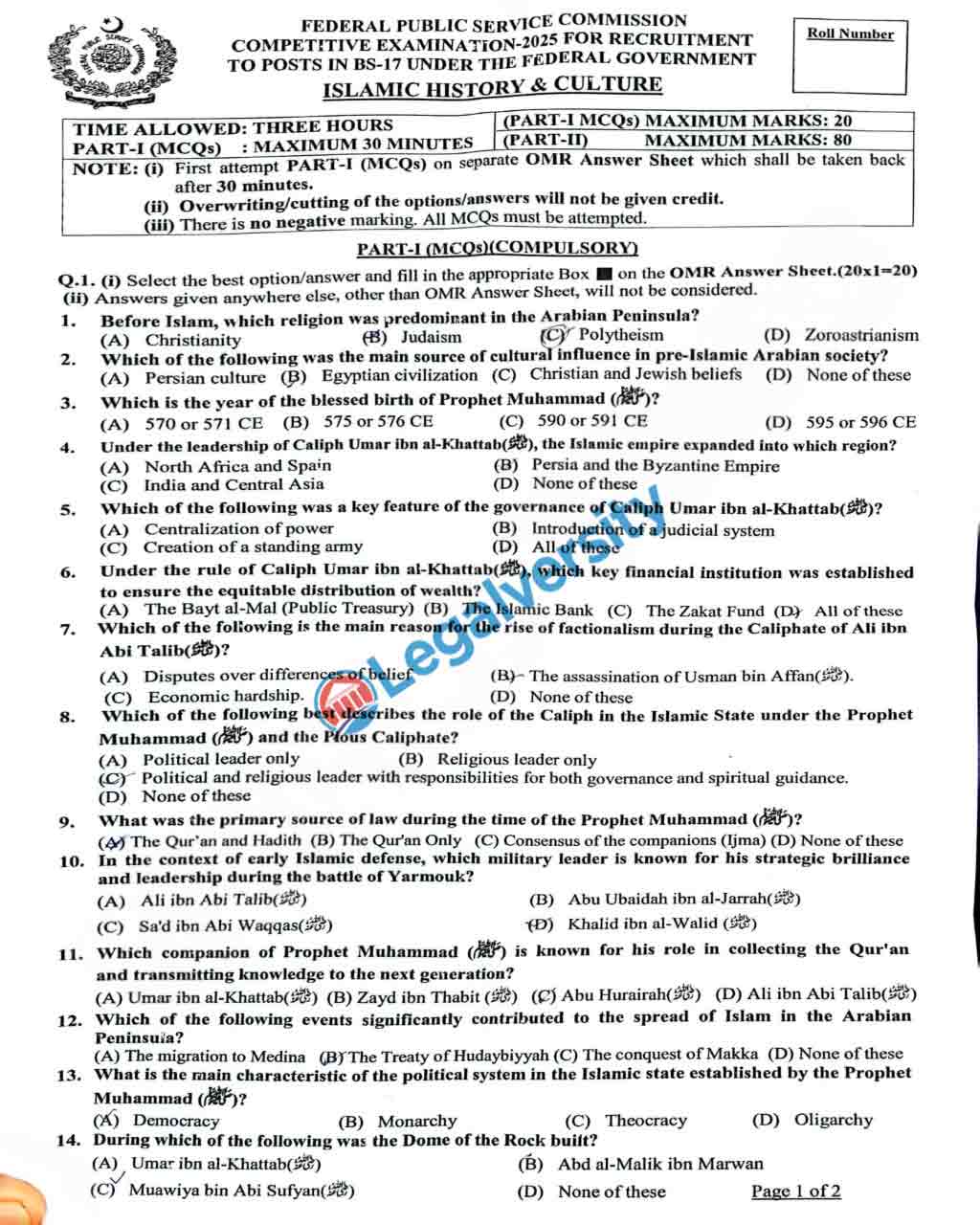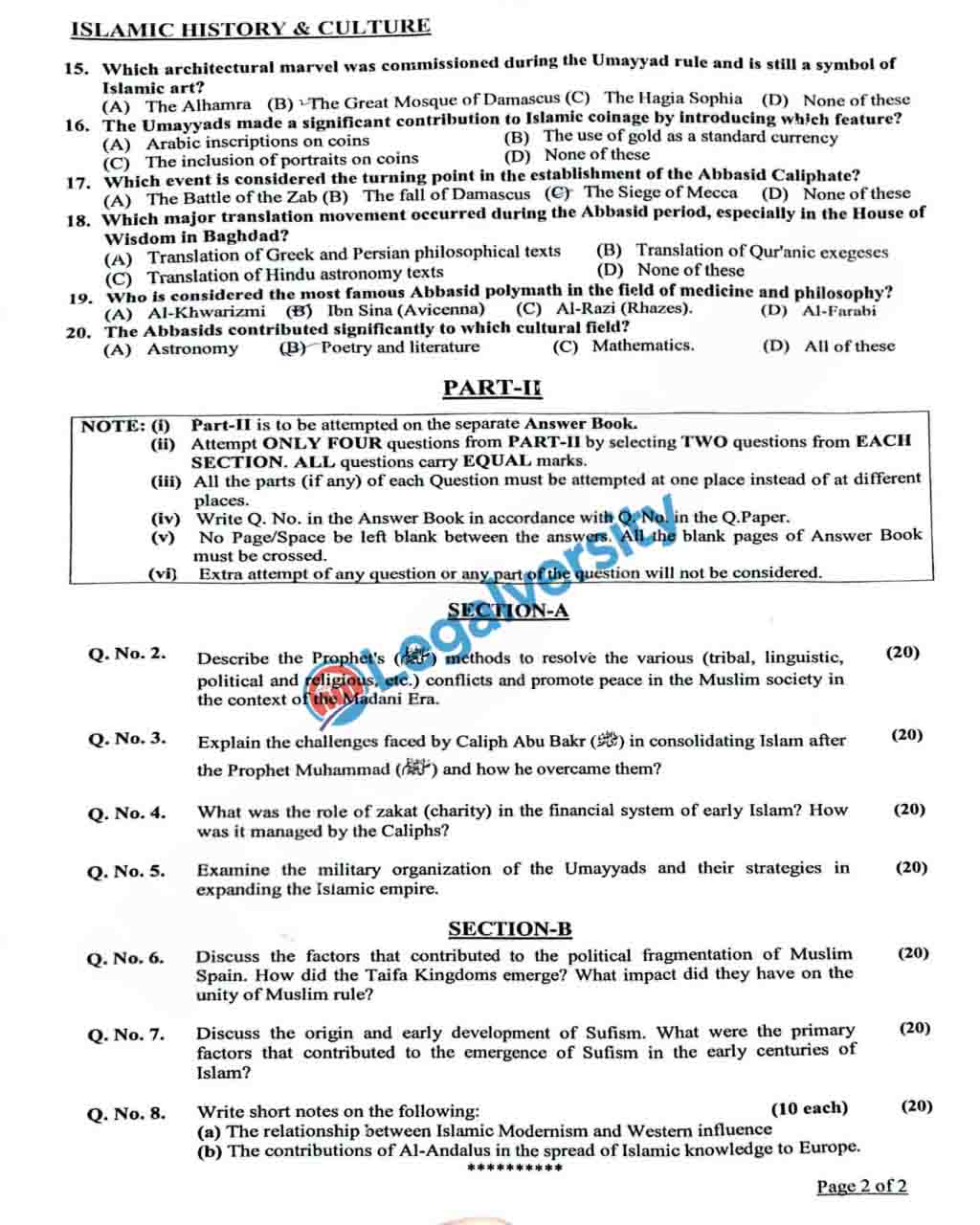The paper on Islamic History is optional in the CSS competitive examination 2025. Here, you will find the CSS Islamic History past Paper 2025. I will also provide a summary of the paper, in which you will analyze what topics were given and how difficult they were. This lets you better understand the concept of paper and prepare well for future examinations.
CSS Islamic History & Culture Past Paper 2025
SECTION-A
Q1. Describe the Prophet’s (PBUH) methods to resolve the various (tribal, linguistic, political religious, etc.) conflicts and promote peace in the Muslim society in the context of the Madani Era.
Q2. Explain the challenges faced by Caliph Abu Bakr (RA) in consolidating Islam after the Prophet Muhammad (PBUH) and how he overcame them.
Q3. What was the role of zakat (charity) in the financial system of early Islam? How was it managed by the Caliphs?
Q4. Examine the military organization of the Ummayyads and their strategies for expanding the Islamic empire.
SECTION-B
Q5. Discuss the factors that contributed to the political fragmentation of Muslim Spain. How did the Taifa Kingdoms emerge? What impact did they have on the unity of Muslim rule?
Q6. Discuss the origin and early development of Sufism. What were the primary factors that contributed to the emergence of Sufism in the early centuries of Islam?
Q7. Write short notes on the following:
- The relationship between Islamic Modernism and Western influence
- The contributions of Al-Andalus in the spread of Islamic knowledge to Europe
Critical Analysis of the Paper
During the Madani Era, the Prophet Muhammad (PBUH) employed several methods to resolve conflicts and promote peace among various groups, including tribal, linguistic, political, and religious factions. The Constitution of Medina (Mithaq-e-Madina) was a landmark document that established a multi-religious state where Muslims, Jews, and other tribes coexisted under mutual agreements.
The Prophet (PBUH) also emphasized brotherhood (Mu’akhat) between the Muhajirun and Ansar, reducing economic and social disparities. His strategy of diplomacy and treaties, such as the Treaty of Hudaybiyyah, demonstrated his commitment to peaceful conflict resolution. Moreover, his forgiveness of the Quraysh after the conquest of Mecca set a precedent for reconciliation, ensuring stability in the newly unified Muslim society. After the Prophet’s (PBUH) passing, Caliph Abu Bakr (RA) faced serious challenges in consolidating Islam, including the Ridda Wars (wars against apostasy), where several tribes rejected Islam or refused to pay zakat.
Some even claimed prophethood. Abu Bakr (RA) swiftly quelled these rebellions through military action, ensuring the political and religious unity of the Muslim Ummah. Another major challenge was the Byzantine and Persian threats, which he countered by initiating military campaigns that later laid the foundation for Islamic expansion. His strong leadership and reliance on the Shura (consultation system) helped stabilize the nascent Islamic state. Zakat (charity) was a crucial pillar of the early Islamic financial system. It was institutionalized during the Prophet’s (PBUH) time and later systematically managed by the Caliphs.
Abu Bakr (RA) applied zakat collection, even going to war against those who did not pay. The collected money was given to the poor, orphans, debtors, and needy, maintaining economic justice. Caliph Umar (RA) additionally organized the distribution of zakat by establishing officials for its collection and distribution. This not only reduced poverty but also fortified the social structure of the Islamic state.
The Umayyad military structure was well organized, with a professional standing army that facilitated the speedy expansion of the Islamic empire. Their tactics involved naval warfare, which helped them control the Mediterranean, and a well-organized cavalry force, which facilitated quick military campaigns. The Umayyads built garrisons and fortresses, including in North Africa and Spain, to protect their lands.
They also utilized diplomatic marriages and alliances with local rulers to maintain control. Under leaders like Mu’awiya I, the Umayyads developed a bureaucratic system that ensured stable governance of the vast empire. The political fragmentation of Muslim Spain (Al-Andalus) was a result of internal divisions, succession disputes, and external Christian pressures. After the fall of the Umayyad Caliphate of Cordoba (1031), the region splintered into multiple small Taifa kingdoms, each ruled by local Muslim leaders. These kingdoms often fought among themselves, weakening Muslim unity. This division made it easier for the Reconquista forces (Christian kingdoms) to gradually reclaim Muslim-held territories.
Despite their fragmentation, the Taifas contributed to cultural and intellectual developments, as rulers competed to patronize scholars, poets, and scientists. Sufism originated as a response to the materialism and political struggles that emerged in the Islamic world after the early Caliphs. It emphasized spiritual purity, devotion to Allah, and asceticism.
The early Sufis, such as Hasan al-Basri, renounced worldly pleasures and focused on developing a personal connection with Allah. Factors such as the influence of Quranic spirituality, Persian mysticism, and early Islamic asceticism contributed to the rise of Sufism. Over time, Sufi orders (Tariqas) like the Qadiriyya and Naqshbandiyya spread, shaping Islamic spirituality across different regions.
Short Notes
1. Islamic Modernism and Western Influence: Islamic Modernism emerged in the 19th century as a response to Western colonialism and modernization. Thinkers like Jamal al-Din Afghani and Muhammad Abduh sought to reconcile Islam with modern science, democracy, and rationalism while resisting Western imperialism. They argued that Islam was compatible with progress and that Muslims should reform educational, legal, and political institutions without abandoning Islamic principles.
2. Contributions of Al-Andalus in Spreading Islamic Knowledge to Europe: Muslim Spain (Al-Andalus) played a pivotal role in transmitting Islamic knowledge to medieval Europe. Cities like Cordoba and Toledo became centers of learning where Muslim, Christian, and Jewish scholars collaborated. The translation movement helped preserve and transmit Greek, Roman, and Islamic scientific works to the Latin world. Scholars like Ibn Rushd (Averroes) and Al-Zahrawi significantly influenced European thought in medicine, philosophy, and mathematics, shaping the foundations of the European Renaissance.
See the CSS Islamic History Past Paper 2025


You can also read the CSS Notes and view all previous papers on CSS
